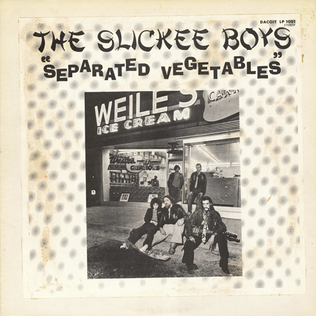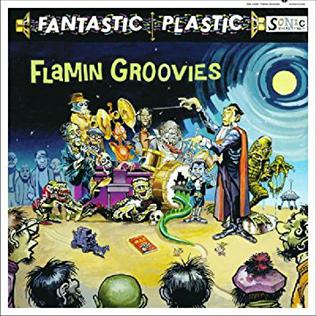
David William Edmunds is a Welsh singer-songwriter, guitarist and record producer. Although he is mainly associated with pub rock and new wave, having many hits in the 1970s and early 1980s, his natural leaning has always been towards 1950s-style rock and roll and rockabilly.
Flamin' Groovies is an American rock band that formed in San Francisco in 1965, originally co-led by Roy Loney and Cyril Jordan. After the Groovies released three albums, on Epic (Supersnazz) and Kama Sutra, Loney left the band in 1971. He was replaced as co-leader by Chris Wilson, and the band's emphasis shifted more toward British Invasion power pop.

On Parole is a studio recording released by British rock band Motörhead. It was intended as their first album and left unreleased at the time of its completion in 1976, and it was not released until over three years later, on 8 December 1979, after the commercial success of Overkill and Bomber that same year. It was released without the band's permission, and they consequently distanced themselves from it. As a result, it was not considered an official release by the band at the time and they did not want it released, as they had moved on, since then, first to Chiswick Records and then to Bronze Records.

Shake Some Action is the fourth studio album by American rock band the Flamin' Groovies. The album was released in June 1976 by Sire Records. The title Shake Some Action originates from a line in the 1965 film None but the Brave.

Rockfield Studios is a residential recording studio located in the Wye Valley just outside the village of Rockfield, Monmouthshire, Wales. It was originally founded in 1963 by brothers Kingsley and Charles Ward.
Michael Ray Wilhelm was an American guitarist, singer and songwriter, best known as a founding member of the influential Bay Area band the Charlatans, who have been widely credited as starting the Haight-Ashbury psychedelic scene during the 1960s. He later played with the bands Loose Gravel and the Flamin' Groovies.

Separated Vegetables is the first full-length album by Washington, D.C.'s Slickee Boys. Self-released on guitarist Kim Kane's Dacoit label, it was pressed in an edition of 100 copies. As well as songs written by the band, it includes cover versions of songs originally by Overkill, Flamin' Groovies, the Road Runners, Johnny Smith, Country Joe and the Fish, the Small Faces, Chuck Berry, and the Hangmen (whose song, "What a Girl Can't Do", the Slickee's had already released on their debut record, 1976's Hot and Cool EP. A mix of studio and live recordings, the album includes a number of tracks taped in front of an appreciative audience at D.C. punk dive the Keg.

Teenage Head is the third studio album by the San Francisco rock band Flamin' Groovies, released in March 1971 by Kama Sutra Records.

Groovies' Greatest Grooves is a 1989 compilation album by U.S. rock band the Flamin' Groovies, released by Sire Records. The tracks were selected by Rolling Stone Senior Writer Michael Goldberg and freelance rock critic Michael Snyder, who also co-wrote the liner notes. Goldberg and Snyder wanted to emphasize the Groovies' original material, and so 18 of the album's 24 songs are Groovies originals.

Chris Wilson is a guitarist and multi instrumentalist, most known for his role as the singer of the best-remembered line-up San Francisco band the Flamin' Groovies, having replaced original singer Roy Loney in 1971. With Wilson on lead vocals, the band released their influential 1976 album Shake Some Action.
Cyril Jordan is a guitarist and founding member of San Francisco cult band the Flamin' Groovies. Jordan founded the band in 1965, playing with them until they initially disbanded in 1992.

Flamingo is the second studio album by the rock band the Flamin' Groovies. It was released in 1970. Following the group's departure from the Epic record label, it was the first of their two albums for Kama Sutra Records.

Supersnazz is the debut studio album by the rock band the Flamin' Groovies. It was released in 1969 on the Epic label. The release was their only album recorded expressly for a major record label, although all of their next five albums were distributed by major labels. Supersnazz was later released in compact disc format in 2000 on Sundazed Records with four edits of songs from the album included as bonus tracks.

Flamin' Groovies Now is a studio album by The Flamin' Groovies, released in 1978. It was produced by Dave Edmunds, and marked a resurgence of the San Francisco band. It brought them to international audiences informed by the post-punk ethic of simplicity that chimed with their classic West Coast melodic pop.

Bucketfull of Brains was a London-based music magazine, founded in 1979 and published until 2015. An associated record label was launched in 2010.

Fantastic Plastic is the ninth studio album by The Flamin' Groovies, released on September 22, 2017, and produced by Cyril Jordan and J. Jaffe. The first new album from the Groovies since 1993, it features the reunion of the Groovies most commercially successful line-up, the classic 1970s combo of guitarists/vocalists Jordan and Chris Wilson and bassist George Alexander, who recorded three albums together before splitting up in 1981.

One Night Stand is an album by the Flamin' Groovies. It was released in 1987 and produced by Cyril Jordan, who also provided the cover art. The album was recorded "live in the studio" in a single night in Australia by the then-current version of the Groovies during a "grueling" tour of Australia, Japan and Europe.

Rock Juice is the eighth studio album by the Flamin' Groovies, released in September 1993 and produced by Cyril Jordan, who also provided the cover art, and Karl Derfler. The album was completed by Jordan and Groovies' bassist George Alexander after the group's breakup in 1991, and they are the only musicians credited in the liner notes.

Step Up is a compilation album of in-studio demos recorded by the Flamin' Groovies in the San Francisco Bay Area between 1984 and 1989 and released in 1991. The demos were produced by Cyril Jordan and engineered and mixed by Karl Derfler, and the album was released shortly after the band broke up. However, after the breakup, eight of the 13 songs were reworked and remixed by Jordan and Derfler, along with removing all lead and backing vocals except for those by Jordan and Groovies' bassist George Alexander, and were then ultimately issued on the Groovies' eighth studio album Rock Juice in 1993.

Roy Loney was an American rock musician, best known as the original lead singer of the Flamin' Groovies. The Groovies original line-up issued releases on Epic Records and Kama Sutra Records, which Rolling Stone magazine described as an "influence on power-pop and punk …" Loney's albums with the Flamin' Groovies included Sneakers (EP), Supersnazz, Flamingo, and Teenage Head.Billboard magazine contrasted their "gritty" sound to the "flower power" approach of their San Francisco contemporaries.

















